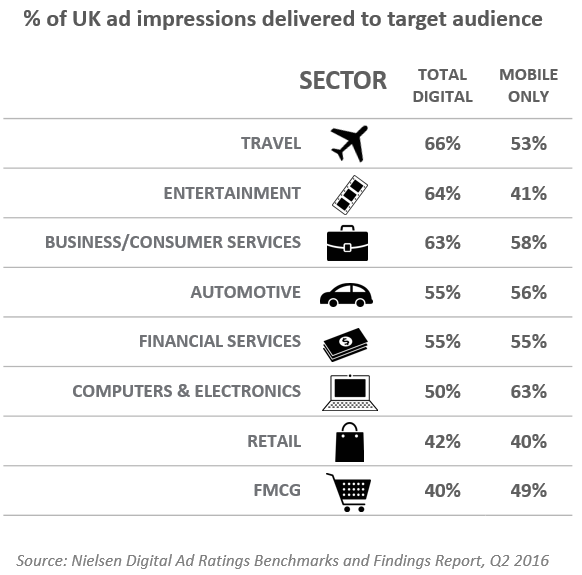Only half (53%) of ad impressions served in Britain are being viewed by the intended target audience, a new study has found.
Investigating over 44,000 campaigns in 17 countries, including 3,400 in the UK, run between April and June this year, measurement company Nielsen found that success rate varied across regions, with Britain performing worse than Germany (58%) and Italy (57%), but better than France (43%).
Nielsen’s Digital Ad Ratings service, which measures the performance of apps, websites and online services, believes the fluctuation in success rates to be affected by factors such as demographics, device and industry.
Nielsen’s marketing effectiveness director in the UK and Ireland Barney Farmer found the results to be far from ideal.
“Although 100% accuracy is likely to remain a pipe dream, a school report on digital technology’s ability to hit specific audiences might read ‘could do better’,” he said.
Low performance
In terms of sector-by-sector analysis, travel, entertainment, and business and customer services currently lead the way in Britain; reaching over half of the groups of people of the age and gender intended (66%, 64% and 63% respectively), while retail (42%) and fast-moving consumer goods (40%) are at the tail end of the list.
Taking into account demographics, the study found that the success rate is best when targeting 35-64 year olds (58%) and worst for 25-44 year olds (38%).
The choice of device also affects performance. Reaching users works equally well for both desktop and mobile campaigns when targeting broad audiences (53% and 52% respectively), but if the intended group is more narrow, mobile campaigns get better results.
The report has also concluded that campaigns bought directly from a publisher perform slightly better (55%) than those acquired via a third-party platform (52%).
Increasing visibility
In sharing this kind of data for the first time, Nielsen is aiming to improve transparency in the advertising space.
According to Farmer, there should be more visibility for both advertisers and agencies about the performance of their campaigns from independent third parties, rather than publishers.
“At the moment, there’s plenty of reporting on standard delivery – such as amount of impressions and level of viewability – but nowhere near enough about who campaigns actually reached,” he added.
Although the results leave much to be desired, Farmer is confident the success rates are increasing “all the time” and mobile in particular should see better performance in the future as it reaches narrower audiences and further builds its prominence as “the most highly-personal ad medium”.


